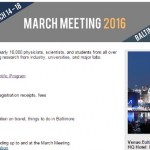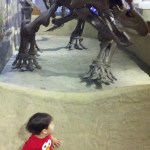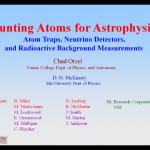Meetings
I was at the APS March Meeting last week, because I needed tp give a talk reporting on the Schrödinger Sessions. But as long as I was going to be there anyway, I figured I should check out the huge range of talks on areas of physics that aren't my normal thing-- in fact, I deliberately avoided going to DAMOP-sponsored sessions.
This also affected my blogging, so the last few weeks' worth of posts at Forbes have mostly been on March Meeting-related areas:
-- How Cold Atoms Might Help Physicists Understand Superconductors: A post about the connection between ultra-cold atomic physics and…
I'm going to be at the March Meeting of the American Physical Society in Baltimore next week. This is the largest physics meeting of the year, with an emphasis on condensed matter physics (which is actually the largest single area of study within physics, though media overemphasis on particle physics and astrophysics might lead you to think otherwise). The program for the meeting is, um, kind of intimidating.
So, this post has two purposes:
1) If you're also going to be at the March Meeting, let me know, and maybe we can arrange some kind of bloggy-people meet-up.
2) More importantly, if…
I've been really, really bad about using this blog to promote stuff I have coming up, but I'll be doing two public-ish appearances in the month of March, and I probably ought to announce those here:
1) Next week, on Wednesday, March 2, I'll be giving the Physics Colloquium at the University of Illinois, on public communication stuff:
"Talking Dogs and Galileian Blogs: Social Media for Communicating Science"
Modern social media technologies provide an unprecedented opportunity to engage and inform a broad audience about the practice and products of science. Such outreach efforts are…
I've been a little bad about self-promoting here of late, but I should definitely plug this: I'm speaking at the TEDxAlbany event this Thursday, December 3rd; I'm scheduled first, at 9:40 am. The title is "The Exotic Physics of an Ordinary Morning":
You might think that the bizarre predictions of quantum mechanics and relativity– particles that are also waves, cats that are both alive and dead, clocks that run at different rates depending on how you’re moving– and only come into play in physics laboratories or near black holes. In fact, though, even the strangest features of modern physics…
I've been doing a bunch of conferencing recently, what with DAMOP a few weeks ago and then Convergence last week. This prompted me to write up a couple of posts about conference-related things, which I posted over at Forbes. These were apparently a pretty bad fit for the folks reading over there, as they've gotten very little traffic relative to, well, everything else I've posted during that span. Live and learn.
Anyway, I'm fairly happy with how both of those turned out, and on the off chance that they'll do better with the ScienceBlogs crowd, let me link them here:
-- What Are Academic…
I spent the last few days in Ontario, attending the Convergence meeting at the Perimeter Institute. This brought a bunch of Perimeter alumni and other big names together for a series of talks and discussions about the current state and future course of physics.
My role at this was basically to impersonate a journalist, and I had a MEDIA credential to prove it. I did a series of posts at Forbes about different aspects of the meeting:
-- The Laser Cavity was Flooded: a revisiting of the idea of True Lab Stories, which was a loose series of funny disaster tales from the early days of…
I've updated the detailed blog post describing our summer workshop introducing writers to quantum physics to include a link to the application form. For the benefit of those who read via RSS, though, and don't follow me on Twitter: the application form is now live, and will be for the next few weeks. We expect to make acceptance decisions around April 1.
So, if you make up stories and the idea of spending a few days at the Joint Quantum Institute learning about quantum physics from some of the world's leading experts sounds like fun, well, send us an application.
A few years back, I became aware of Mike Brotherton's Launch Pad Astronomy Workshop, and said "somebody should do this for quantum physics." At the time, I wasn't in a position to do that, but in the interim, the APS Outreach program launched the Public Outreach and Informing the Public Grant program, providing smallish grants for new public outreach efforts. So, because I apparently don't have enough on my plate as it is, I floated the idea with Steve Rolston at Maryland (my immediate supervisor when I was a grad student), who liked it, and we put together a proposal with their Director of…
Back in August, I gave a talk in Stockholm at the Nordita workshop for science writers, about precision measurement searches for physics beyond the Standard Model. There's now video of this online:
The video quality isn't great, but if you'd like a clearer look at the slides, I've posted them on SlideShare. The talk was divided into two parts, though the video is not:
Part 1:
High Precision, Not High Energy: Using Atomic Physics to Look Beyond the Standard Model (Part I) from Chad Orzel
Part 2:
High Precision, Not High Energy: Using Atomic Physics to Look Beyond the Standard Model (…
Matt "Dean Dad" Reed has a post about the issue of academic conference travel, which is expensive and often the first thing cut out of college budgets. Which leaves faculty either disconnected from their field, or paying out-of-pocket to attend meetings that they need to demonstrate their scholarly productivity. This, in turn, tends to skew research meetings even more toward those at elite schools with big budgets.
This is a hard problem to crack, because the issue isn't just money but time. Reed suggests dropping "the charade of the last half day" because it requires an extra night in a…
Having just returned from a long trip where I gave three talks, one of the first things I saw when I started following social media closely again was this post on how to do better presentations. The advice is the usual stuff-- more images, less text, don't read your slides, and for God's sake, rehearse the talk before you give it-- and it's generally very good. Given the two very different types of presentation I gave over the last few weeks, though, I think it's important to add one note about the design of the visuals, which is this: when you're putting a talk together, keep the final…
I didn't write a summary of the third day of "Quantum Boot Camp" to go with my Day One and Day Two summaries for a simple reason: I would've needed to do that on Saturday, and I spent Saturday in transit back to the US. More than that, though, it was harder to summarize than the other two days, because my talk was the middle of three, and thus I spent most of the first talk fiddling with my slides and fretting, and most of the third fighting off the post-talk adrenaline crash.
Happily, Sedeer at Inspiring Science offers a summary of the first two talks, namely Larus Thorlacius from Nordita…
The second day of the "Quantum Boot Camp" was much lighter on talks. The only speaker was Ray Laflamme from the Institute for Quantum Computing in Waterloo, who gave a nice introduction to quantum technologies. While he did spend a bit of time at the start going through Shor's algorithm for factoring numbers (following up a discussion from Wednesday), he mostly focused on ways to use quantum physics to improve sensors of technological interest.
So, for example, he talked about how efforts to develop techniques for error-correcting codes in liquid state NMR quantum computing led to the…
Since this part of the trip is actually work-like, I might as well dust off the blog and post some actual physics content. Not coincidentally, this also provides a way to put off fretting about my talk tomorrow...
I'm at the Nordita Workshop for Science Writers on quantum theory, which a couple of the attending writers have referred to online as boot camp, though in an affectionate way. The idea is to provide a short crash course on cool quantum physics, so as to give writers a bit more background in subjects they might need to cover.
The first talk was from Rainer Kaltenbaek (whose name I…
The kids and conferences issue, discussed here a while ago has continued to spark discussion, with a Tenure She Wrote piece on how to increase gender diversity among conference speakers and a Physics Focus blog post on a mother who wound up taking her toddler to a meeting. There are some good points in both, though the Tenure She Wrote poster seems to be in a field whose conferences run on a different model than that used for most meetings I go to.
The Physics Focus post was particularly interesting to me, though, because I spent last weekend as the portable conference day-care while Kate…
As previously noted, I spent most of last week at the 2013 DAMOP meeting, where I listened to a whole bunch of talks. At some point, I was listening to a talk, and said "I bet this guy hasn't given a lot of these before." What was the give-away? The fact that he almost never said "Um."
To the dismay of many students entering science majors, public speaking is a very significant part of being a professional scientist. Scientists are expected to give talks of a variety of different lengths-- 10-15 minute "contributed" talks at big meetings, 25-30 minute "invited" conference talks, 45-60 minute…
Today's Links Dump came late because I was at the meeting of the APS's Committee on Informing the Public. We apologize for the inconvenience, but I was too busy acquiring this critically important scientific data:
What is that, you ask? It's this:
That's the Superman roller coaster at the Six Flags America park outside of DC, which is where we're meeting this time. Lots of amusement parks do Physics Days as outreach programs, so we did the Physics Day thing ourselves, wearing ugly blue vests holding accelerometers on the major rides. Of course, the vest-mounted accelerometer I was wearing…
The fourth content area from my whirlwind overview of DAMOP is "traditional" AMO physics. This was the hardest to talk about in my talk, because I know it the least well, but ironically, that makes it really easy to write up here, because I don't have much to say about it.
Where the other areas were largely about using atomic, molecular, and optical physics to do stuff (simulating condensed matter systems, generating coherent x-rays, demonstrating cool quantum effects), this sub-sub-field is concerned with directly investigating the properties of atoms and molecules, usually by bouncing other…
I'm going to be at an amusement park tomorrow, for a meeting of the APS's Committee on Informing the Public, which oversees the APS outreach program. Why an amusement park? Because a common outreach-type program is to do a Physics Day at an amusement park and talk about the physics of roller coasters and the like. And why should we miss out on all that fun? we have a responsibility to make sure that the physics content of these programs is sound.
As part of this, I'll be going on a bunch of rides-- for SCIENCE, mind you-- and it occurs to me that while the park or the APS may supply some sort…
The first of the five categories of active research at DAMOP that I described in yesterday's post is "Ultracold Matter." The starting point for this category of research is laser cooling to get a gas of atoms down to microkelvin temperatures (that is, a few millionths of a degree above absolute zero. Evaporative cooling can then be used to bring the atoms down to nanokelvin temperatures, reaching the regime of "quantum degeneracy." This is, very roughly speaking, the point where the quantum wavelength of the atoms becomes comparable to the spacing between atoms in the gas, at which point the…




